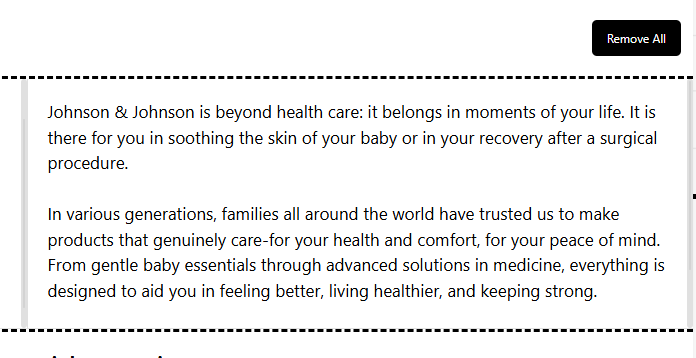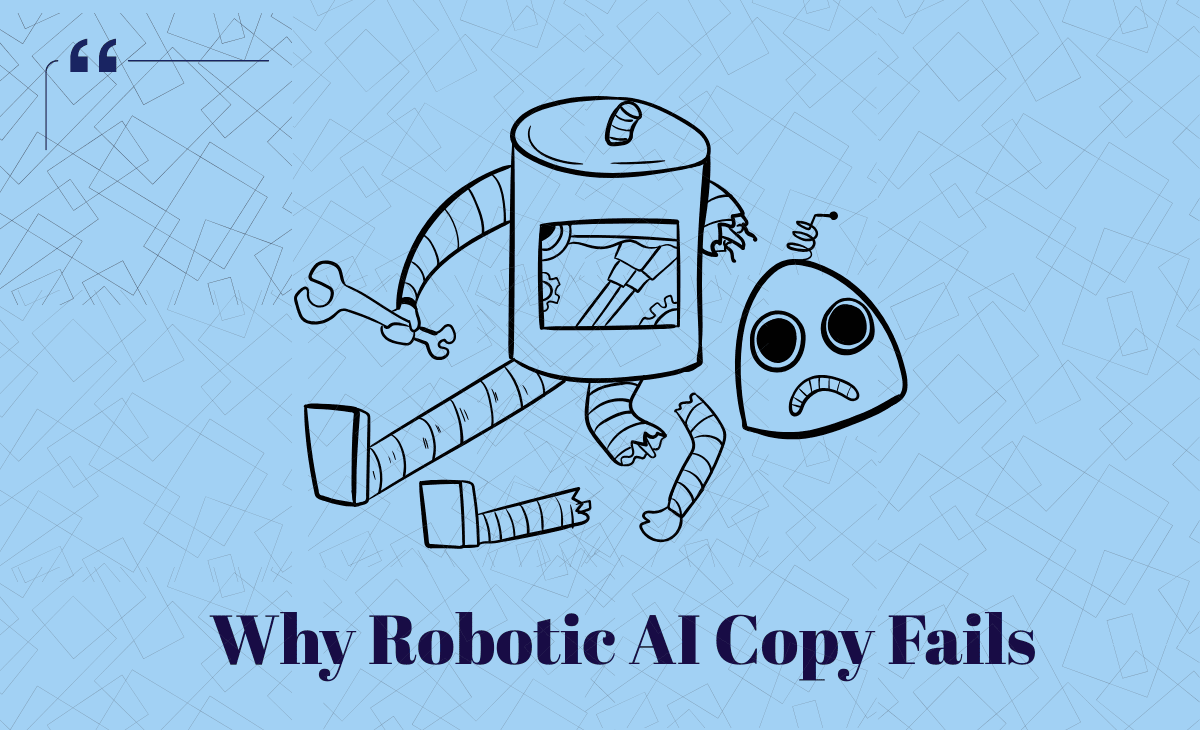“Story of Woman Who Rescues Shelter Dog With Severely Matted Fur Will Inspire You to Open a New Tab and Visit Another Website”. This was one of the many headlines that stirred a debate a few years back when code-davinci-002 tried its hand at writing. It is a textbook case of why robotic AI copy fails and how risky it is for it to take control of the creatives.
However, things have drastically changed since then, and we are seeing our AI models generating more coherent and useful content. But there is still a lot of confusion from a marketing perspective. AI meets us halfway with its efficiency and speed, but lacks massively in creativity and forming a connection.
At this point, looking back into things or a deep analysis of the present AI-driven content scenario is critical. As it's only then we can get a perspective of why AI with all its efficiency, is still a risky choice.
What is Robotic AI Copy?
Robotic AI copy is the content generated by artificial intelligence for your brand. In simpler terms, it is when you use an AI tool to help you write. The process of generating content with AI is very simple, and all it takes is to feed it the required prompt.
But the challenge of AI-generated content is not about swiftness or ease of access. It is about the lack of creativity and the missing contextual awareness that fail to grab attention. If you regularly use AI writing tools, you will notice that they always have the same tiring approach of repetitive words, rigid patterns, and a false sense of connection.
To help you understand this better, I had asked ChatGPT to generate a sample ad copy for Johnson and Johnson, and this is how it went:
ChatGPT generated Johnson and Johnson Copy
As you can see here, even though the writing is grammatically immaculate, it won’t survive a day in today’s competitive marketing scenario. It shows that it has been trained on average ad copies that provide no unique perspective. More than a catchy piece, it looks like an informational manual that you can’t wait to scroll past!
6 Painfully Common Traits of Robotic Copy
There are certain red flags in AI-generated content that are too tough to ignore and can ruin the entire experience. Running an ad like the one ChatGPT generated for us can cause some damage to your brand that may take you some time to fix.
💡Quick Tip: If you want to know why robotic copy mostly fails, you need to ask a basic question: How well can you identify the target audience from a given ad?
If you look at this given piece closely, you will find that ChatGPT did identify the main target audience. However, it also presented an ambiguity with “medical innovations” that makes the reader confused. Not only that it also missed out on some major aspects, which include:
🚩 No emotional connection: Caring for a baby can be one of the pleasant and biggest things in one’s life. But not only does this ad sound like a chore, but it somehow robbed the product of its authenticity. Moreover, it failed in evoking warmth and reassurance, a non-negotiable for a brand like this one.
Ask yourself this: If you were not familiar with the legacy of Johnson and Johnson, would you have ever trusted it to take care of your baby with this ad?
🚩 Keyword Dumping: With words like “healthcare,” “solutions,” and “medical innovations,” you will never be able to communicate in the right tone. This looks like the writer here wrote only to appease the Google algorithm rather than its readers.
🚩 Lacks Personalization: The copy fails to connect with new mothers or fathers, as it generalizes the concept. It fails to form a bond with them as there is personalization catering to their needs while taking care of their baby.
🚩 Zero Storytelling or Visual Language: A great brand copy leaves nothing to the imagination. It is not only crisp and personal, but it is also a visual trip in itself. The idea is to tell a story in such a way that your reader is inside the experience of taking care of a newborn child.
🚩 Tone-Deaf Brand Voice: For somebody who’s unaware of Johnson and Johnson, will assume that this copy is for a medicine brand. It reads like a Pharma piece and takes away the essence of the brand, that is, the joy of infant care.
🚩Vague, Blanket Statements: You will see thousands of brands talking about improving your life. It not only has become repetitive, but also makes your audience wonder about the vagueness of the product you are trying to sell. A copy like the one ChatGPT generated will only make your readers question your brand purpose, and that’s it.
SEO and Engagement: Why Robotic Copy Hurts Your Rankings
When you write to sell your brand, you cannot rely on just your creativity. You have to be mindful of SEO practices if you want your copy not only to rank but also to ensure conversions. At this point, both readability and engagement are what’s going to save the day for you.
Our present setup is all about writing content in a way that Google finds helpful for its users. The content that you see ruling the top spots has ensured they not only connect with the audience but also offer innovation.
Search Engine Optimization is a vast subject and requires an in-depth understanding of the same. But if you wish to know the basic framework of how Google ranks content, all you need to know here is E-E-A-T (Experience, Expertise, Authoritativeness, Trust).
- Experience: Google loves content that comes from a firsthand experience. If you have used the product and are writing about it, Google will be happy to promote it. It prioritizes product reviews, case studies, or personal insights, as you have lived the experience of using it.
- Expertise: When you Google something, it is mostly because you need an expert’s advice. That’s how Google has designed its algorithm: it will only push content that knows what it is talking about. You will never find it prioritizing generic content for a specific query.
- Authoritativeness: This is where you have to convince Google that you are a legitimate, credible source. It can be through credible mentions or backlinks, and whatever.
- Trust: Trust is the backbone of your entire marketing setup. You should have a secure website that makes no fake claims or has clickbait.
🚨Now that you have an insight into what Google looks for in content, ask yourself this one simple question: Does ChatGPT generate the copy capable enough to meet E-E-A-T standards? You will quickly see why AI-generated copy often falls short when it comes to converting.
Humanized vs. Robotic Copy
At this point, we know that AI-generated content will lead us nowhere. But we also know that letting go of AI’s efficiency can slow us down and affect the overall business.
So, our need for“ Humanizing” AI content is forever on the rise as we try to navigate through competition. Imagine you have multiple AI-generated briefs to work on for your website. You know that refining each copy will take time and creative effort. Moreover, if you let go of your set target, it means stepping down from the competition. So, the ideal way to solve this problem?
💡This is where Humanize AI comes in to save your day!

You will notice that it took the robotic copy and gave it a more personalized approach to the narrative.
✅You will see a drastic shift in the narrative from stiff and generic to personal, warm, and trustworthy. As a new caregiver, you feel seen reading this ad and form an instant connection with the brand.
✅Using the exact same ChatGPT results, the humanized copy seems to understand its user base and depicts what it's like to be in their shoes. It is no longer a tired narrative but an interesting perspective that opens up a space for connection.
✅ Humanize AI not only modified the copy, but it felt like it came from a real person with real emotions and real understanding.
Conclusion
Robotic AI copy fails massively at every step of the way. It neither connects to the audience nor does it help you retain your brand voice. But it is not possible to let go of AI and its other privileges.
As we realize the fact that copy is not about decorated words and is more about connection, we tend to look for efficient alternatives. This is how we design a powerful workflow for ourselves that includes keeping AI and human creativity in sync.
It is as simple as Prompt > AI Generates Content> Humanize AI optimizes it in seconds.
The moment you understand that your brand’s content is its identity. It has the power to decide how people perceive your online presence and make or break your business. Hence, relying on a setup that only knows shared experience is not a risk but a careless move to push things forward.
FAQs
Why does AI-generated content fail to connect with readers?
AI-generated content relies on generic phrases and offers no deep insights, emotional connection, or personalization with its storytelling for the user to resonate and rely on.
Can AI-generated copy meet Google’s E-E-A-T standards?
No, AI- AI-generated copy fails to meet Google’s E-E-A-T standards. As AI mostly struggles with demonstrating real-world experience, authentic expertise, and trustworthiness for Google to vouch for it.
What are the most common problems with robotic AI copy?
A robotic AI copy sounds more like a summon than an attempt at creative storytelling. It lacks emotional appeal and relies heavily on vague messaging, keyword stuffing, with less care for the brand’s voice or audience intent.
Does AI copywriting help or hurt SEO?
You can scale SEO parameters to an extent with AI copywriting, but you will eventually fall flat on building a quick connection. You will end up with high bounce rates, which will eventually result in catastrophic sales numbers.
Is it possible to use AI tools without compromising content quality?
Yes, with tools like Humanize AI, you can refine your content and enhance its quality than it was before. It helps you achieve that perfect blend of efficiency backed by soulful content that resonates with your users.

